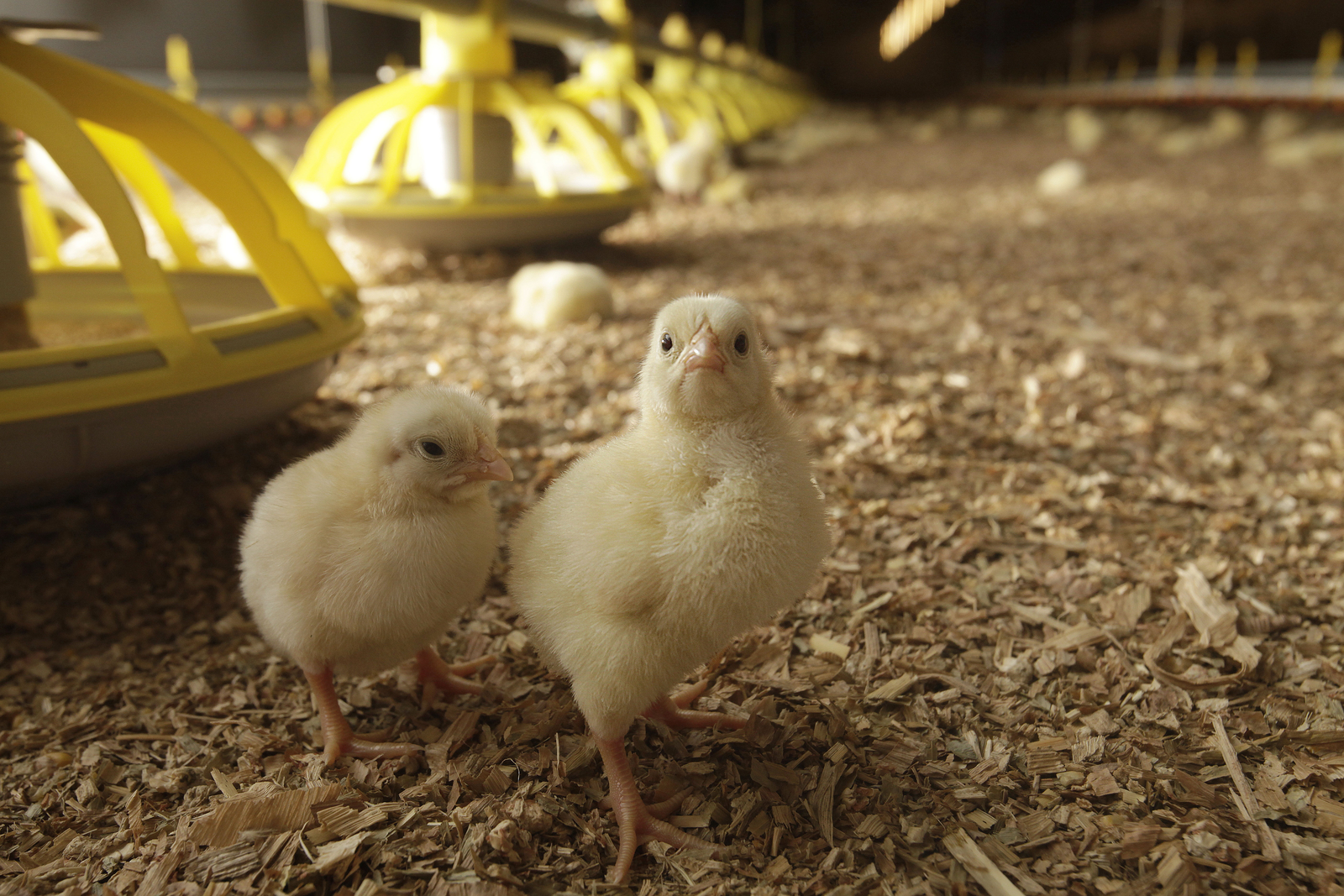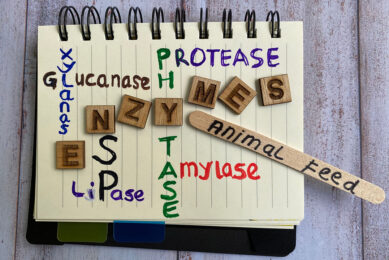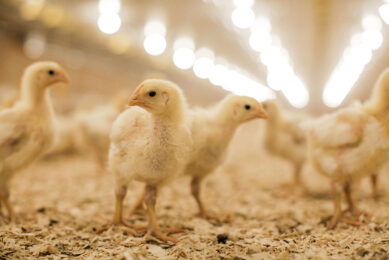Benefits of adding xylanases pre-pelleting

Xylanases have been on the market for quite some years. New insights show that adding these enzymes at the batch mixer, pre-conditioning (instead of post-pelleting) offers a ?number of advantages. Particularly if the enzymes can be added as a liquid.
As temperature levels and conditioning times during the feed manufacture process have increased over the years to meet demands for ever greater levels of feed hygiene and pellet quality, so too has the challenge of applying non-starch polysaccharide (NSP) feed enzymes. Clearly, the target for feed enzyme application is to uniformly and consistently deliver the desired dose of active enzyme to the site of action, namely the gastro-intestinal tract of the animal. However, with many commercial NSP enzymes insufficiently thermostable to withstand the pelleting and hydrothermal conditioning processes employed during feed manufacture, there have been a number of key developments introduced over the years to enable this target to be achieved. These developments have continued, both in terms of enzyme application technology and the enzymes themselves. Pressure to improve feed performance – including feed enzyme efficacy – whilst also reducing costs has also ensured such developments remain a key priority for both enzyme producers and feed manufacturers.
Early application developments
The positive effects of adding NSP enzymes (xylanases) to wheat, rye and tritcale-based animal feeds has been known for over 20 years, with the first commercial use in UK wheat-based broiler feeds in 1989. Research at that time established that the main mode of action in xylanases in poultry fed diets based on these cereals was the reduction in digesta viscosity caused primarily by soluble cereal xylans. However, it was also apparent that xylanases opened up the arabinoxylan-rich aleurone and endosperm cell walls in cereals to release entrapped nutrients while at the same time releasing xylo-oligosaccharides that can have a positive influence on intestinal bacteria. Xylanases are known to increase protein digestibility in wheat and this is attributed particularly to the release of protein from the xylan-rich thick cell-walled protein-rich aleurone layer.

Also read: Kemin launches new xylanase enzyme
When NSP enzymes were first introduced some decades ago, they were initially only available as dry products added to the mash at the batch mixer prior to pelleting. Although the generally lower processing temperatures employed at the time meant the enzymes produced clear benefits in the animal, it soon became clear there were weaknesses in thermostability. This led to the development of equipment for spraying liquid enzymes after pelleting, side-stepping any inherent thermostability weaknesses and producing much better recovery and performance results.
This technology has successfully served the industry for the past two decades, with post-pelleting liquid application (PPLA) installations widespread. The best systems offer a considerable degree of flexibility in terms of both dose rate and the number of products that can be applied simultaneously. Although the first systems were typically able to only achieve coefficients of variation (CVs) of around 20%, the latest equipment can now achieve CVs as low as 10%. Globally, considerable investment has been made in PPLA systems over the years, with a separate system required for each pelleting and processing line. Although effective and widely accepted, the high initial capital expense, plus the need for regular maintenance and calibration, mean that the overall cost of running PPLA systems can be high.
Mixer application technology
The opportunity to revert back to adding enzymes at the batch mixer, pre-conditioning, therefore offers a number of advantages, particularly if those enzymes can be added as a liquid. Adding liquids via the batch mixer is a well-evolved practice for ingredients such as fats, betaine, choline chloride and liquid analogues of amino acids, with the technology both well understood and relatively straightforward to install. Such mixer liquid application (MLA) technology is also significantly less expensive to purchase and maintain than a PPLA system, and there is no requirement for a separate system on each pelleting line.
In addition, research has shown improved uniformity of application when a liquid xylanase is added to the batch mixer instead of post-processing, with CVs as low as 5% for both pellets and mash, along with a potential 4% reduction in pelleting energy costs. However, the use of this MLA technology depends entirely on the development of enzymes that can withstand high temperature feed processing. The search for solutions to the enzyme thermostability challenge has therefore continued, and to date the resulting research and development work has generally fallen into three categories: the use of coating technologies, enzyme engineering and the discovery of new inherently thermostable enzyme candidates.

Also read: Modern xylanases show greater versatility
Thermostable enzyme solutions
The application of a coating to the enzyme can, for example, increase thermostability by limiting water penetration. Although this can achieve close to 100% enzyme recovery after commercial feed pelleting, there are indications from the use of coatings on phytases that there may be a negative effect on enzyme dissolution rates and thus enzyme efficacy. In contrast, re-engineering the amino acid structure of existing enzymes can achieve increased thermostability by making the enzyme itself either more hydrophobic (water repellent) or more tightly structured and stable.
This technology avoids the need for coatings and has been successfully used to produce several commercial enzyme products. However, care must be taken to ensure any changes do not reduce the efficacy of the enzyme. The third option involves the screening of micro-organisms found in warm environments, such as hot springs and deep-sea fissures, for naturally thermostable enzymes. Transferring the genes for such enzymes to a standard producing organism allows large scale production of enzymes that match or exceed previous levels of efficacy, yet are intrinsically highly thermostable – potentially thermostable enough to allow addition to the batch mixer as a liquid.
Thermostability benefits confirmed
Independent testing of the latest generation intrinsically thermostable xylanase to enter the market has confirmed the potential benefits over the most intrinsically thermostable existing products. In one study, this xylanase (Econase XT, Figure 1) was shown to be thermostable at up to 95°C (203°F) under normal pelleting conditions, which in this case included 30 seconds of steam conditioning followed by pelleting through a 3.0 mm die.
In addition, stability tests performed using various conditioning and pelleting processes in a range of commercial feed mills across Europe demonstrated typical recovery rates at between 90-110% of the level observed in the mash. Just as importantly, applying the xylanase as a liquid to the batch mixer produced CVs as low as 5% in both mash and pellets, thanks to the more uniform distribution achieved. Independent investigations with a leading research institute have also highlighted the potential for liquid xylanases added to the batch mixer to lower pelleting power consumption (PPC).
Reducing this major source of power consumption during feed manufacture will not only lower manufacturing costs, but also provide environmental benefits, such as a reduced carbon footprint. In the data shown in Figure 2, the addition of an intrinsically thermostable liquid xylanase reduced the level of power consumed compared to both control diets – basal and basal plus water – by 30% and 13%, respectively. This level of PPC reduction offers real commercial and environmental value for feed manufacturers, and one that should not be easily dismissed.
Animal performance retained
Numerous production trials have also shown that these improvements in thermostability need not compromise enzyme efficacy in the animal, or resulting performance gains. In one such trial, an intrinsically thermostable xylanase was compared with a previous generation product in wheat-based diets – formulated assuming either a 0%, 8% or 10% wheat energy uplift – fed to male broilers. There was no difference in 42 day liveweight, but addition of both xylanases significantly improved (p<0.01) feed conversion ratio (fcr, 0-42 days), with the level of improvement markedly greater with the intrinsically thermostable enzyme. even when the fcr deteriorated as the assumed wheat energy uplift was increased, the thermostable xylanase still produced the best performance (see figure 3).></0.01)>
Conclusion
The development of thermostable xylanases suitable for addition at the batch mixer therefore represents a major step forward for the feed manufacturing sector. Using MLA technology potentially offers both cost savings and improved CVs, and provides an alternative system to the PPLA system for xylanase application.












